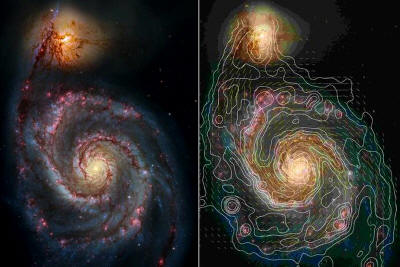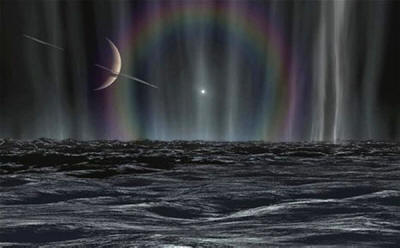|

by Stephen Smith
December 15, 2011
from
Thuntherbolts Website

Saturn's moon
Enceladus
Comet-like jets spew from the south pole of Saturn's moon Enceladus.
Credit:
NASA/JPL/Space Science Institute
Enceladus joins other celestial
objects that produce “magnetic bubbles.”
In a recent Picture of the Day, the so-called “bubbles” of
magnetism supposedly found by the Voyager spacecraft at the boundary
where the Sun’s
heliosphere meets the ISM (interstellar
medium) were explained as Langmuir sheaths, or
electrically charged double layers in plasma.
Since the bubbles are thought to be
elongated, it was suggested that the electron flux variations
detected by the twin Voyagers probably indicate filaments of
electricity called
Birkeland currents.
Similar electromagnetic structures are seen around Earth, on Venus,
on the various gas giant planets, and within and surrounding
galaxies (below image).

All of these phenomena share a common
characteristic: they are all manifestations of electricity flowing
through plasma.
Plasma experiments in the laboratory correspond to plasma formations
in space because of the scalability factor: under similar
conditions, plasma discharges produce the same formations
independent of size, whether in the laboratory or on a planetary,
stellar, or galactic level.
Duration is proportional to size,
however. An electric spark that lasts for microseconds in the
laboratory might last for years at the stellar scale, or for
millions of years at the galactic scale.
Recent observations of Enceladus by
the
Cassini spacecraft in orbit around
Saturn reveal that its electrically charged plumes are also bubbly
with magnetic fields (below image).

Saturn’s “magnetic bubble” is its
magnetosphere, inside of which Enceladus orbits.
The interactions with Saturn are because
the moon acts like a generator, its conducting plasma moving through
Saturn’s magnetic field induces current flow.
An ultraviolet “footprint” of the electric circuit between them was
seen in Saturn’s auroral oval during Cassini’s August 11, 2008
flyby. The onboard plasma sensors found ion and electron beams
propagating from Saturn’s northern hemisphere. Their variability was
puzzling to NASA scientists until time-variable emissions from
Enceladus’ south polar vents were found to correspond with the
auroral footprint’s brightness variations.
Consensus viewpoints assume that the Universe is electrically
neutral, so evidence confirming electrically active plasma is
said to be caused by localized phenomena no matter how improbable.
Tidal “kneading,” “cryo-volcanoes,” and “geysers” erupting from
underground chambers of liquid water are said to cause the activity
seen on Enceladus, while electricity is ignored.
Planetary scientists persist in misinterpreting the “tiger stripes”
on Enceladus as “vents,” channeling water to the surface.
The vents are really incisions on the
moon caused by traveling electric arcs. They are analogous to the
v-shaped trenches seen on
Jupiter’s moon Europa. They are
often found in parallel and they cut across other channels. Such
characteristics contradict the idea that they are a series of
fractures.
It appears that Enceladus was gouged and torn, rather than cracked
and broken.
A giant auger seems to have cut across
the surface, disregarding the prior topography: a sure sign that an
electric arc was the active agent. The tiger stripes show
parallelism not because they are open cracks but because filamentary
electric currents flowing across a surface tend to align and follow
the ambient magnetic field direction.
Electric Universe advocates propose
that
the rilles and hot pole are heated by electromagnetic
induction, while the water vapor is electrically “machined” from
them.
A similar process occurs at the north
pole of Enceladus, where the electric current returns to Saturn’s
plasma sheath.
|



